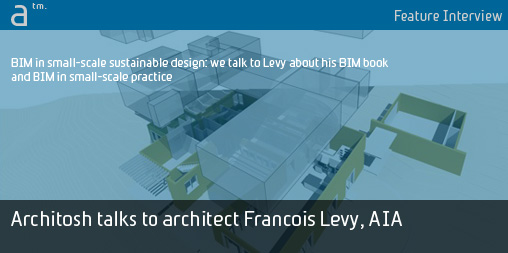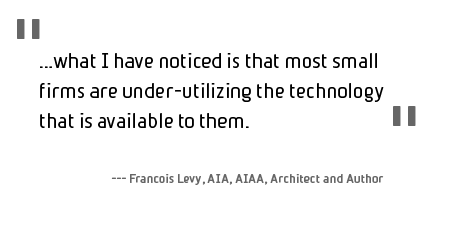Earlier this year architect and educator Francois Levy, AIA, came out with his new book “BIM in Small-Scale Sustainable Design,” published by Wiley Publications. We were excited to hear from him, as Francois has been an encouraging reader of our online publication for many many years and it is always exciting to learn about what our many readers are up to.
Advertisement
We were even more excited when we learned that the new BIM book was focused on BIM usage in small-scale practice. The reason for that is simple. Books on BIM today, and a large array of case studies on transitioning to BIM, are by-and-large centered around large-scale practice. Hospitals, university laboratories, museums and other big projects have undoubtedly moved ahead in BIM (Building Information Modeling) due to both the enormous potential in gained efficiencies and also the investment muscle and resources that typically back such endeavors.
Large-scale practice can, simply put, afford workflow experimentation and process innovation change more easily than small-scale practice. You can section off a small segment of a large practice and say, “we’re not going to worry about profit on this job too much and see what happens.” However, that doesn’t mean–as we learn from Levy in this interview–that small-scale practice should hold back on BIM adoption. If anything small-scale practice may have even more reasons to be enticed by BIM process change. And that is just one of the messages we hear in both the book and the interview.
While our interview delves into the subject of the book, we talk more broadly about BIM in the interview. Levy is an innovative thinker and we would be remiss to not engage him on thoughts about BIM beyond even the book. He shares with us his views on the challenges of BIM adoption in small-scale practice, in addition to covering such topics as generation and firm culture challenges.
[Editor’s note: Architosh’s 2010 BIM Survey Report covers such topics thoroughly in a well-researched and interview-based fielded study. For readers interested in firm cultural challenges in BIM adoption our ISV version of our report contains indepth analysis and extensive firm interviews that shed light on this very subject. You can find this report publication available here.]
The Book
BIM In Small-Scale Sustainable Design is a book that begins by reviewing the emergence of Building Information Modeling (BIM). The first chapter lays out the links between BIM and sustainable design in general and like all the chapters ends with a case study.
Chapter two devotes itself entirely to a discussion of BIM software, as well as complementary BIM applications. Francois Levy is honest in his book about his personal preferences but does a solid job of noting the strengths and weaknesses of nearly all BIM software packages.
The heart and soul of this book however are the chapters 3-10 which focus on sustainable design. Chapter 11 is focused on collaboration. There is a very solid bibliography and set of references in the back as well. Without further ado, let’s begin the discussion.
The Interview
Anthony Frausto-Robledo (AFR): What is your professional background? I know you teach and I know you are a practicing architect as well, can you tell us about yourself?
Francois Levy (FL): Sure, I am first and foremost an architect…a practitioner. Since I live and work in Austin, which is fairly progressive towards environmental and sustainability concerns, those concerns have always been on the radar for me. So the nature of my practice is such that I am always inclined to design with an eye to climate indexing. Particularly with the hot summers and occasional cold winters out here…Austin is a climate that demands respect.
So I came to Austin in the late 80’s to get my master’s degree in architecture and then, like many people that come to Austin, ended up staying. In 2006 I went back to get a master’s degree in architectural engineering with a focus on sustainability. Along the way for the past ten or twelve years I’ve been teaching off and on. Currently I am not teaching.
AFR: When you do teach, what areas do you teach in?
FL: Mostly in what we might call environmental controls and building technology, but I also have taught in digital practice tools like CAD, 3D and BIM.
AFR: Okay, so what brought about the idea to do this particular book?
FL: For most of my career I’ve worked in smaller architectural practices, primarily doing residential work but not always. I had a stint in a larger firm earlier in my career and have done work outside of residential building types. And I also have had a strong interest in technology tools and I’ve become a fairly accomplished Vectorworks user and I am, for instance, the Austin area Vectorworks User Group organizer.
What I’ve noticed is that most small firms are under-utilizing the technology that is available to them. Which of course is completely understandable because as technology gets more sophisticated and complex it can become more daunting and challenging for firms to keep up with.

01 - The use of BIM in architecture starts with benefits not even in the building itself. In this site model--which would eventually hold the BIM--the accuracy of the recommendations for the removal of nine extra inches of soil was confirmed later by the general contractor. (image copyright: Rancho Encino Residence by Agruppo)
AFR: How so in your mind?
FL: If you follow the discussion boards like the AIA TAP boards for example–which are widely cross-referenced–you will see that there is a widely divergent view about the benefits of BIM adoption and the strengths of just staying the course with 2D electronic drafting. So part of my motivation with this book is to help small firms get beyond the poor utilization issue and to start seriously evaluating and adopting BIM…because there is much that can be gained by doing so.
AFR: So what kinds of pro arguments are you hearing about BIM in small-scale practice by those using it? Or what does it seem people are interested in the most about BIM?
FL: Most talk centers around using BIM for productively advances in working drawings. Once you are using BIM, especially as a sole practitioner, the hard line between design and production is quite blurry. We as architects like to design up to the very last minute. But furthermore from my engineering and environmental training I know that there are clear benefits to sustainability that can be gained by implementing BIM into the process early on.
AFR: Can you elaborate on that?







Reader Comments
Comments for this story are closed